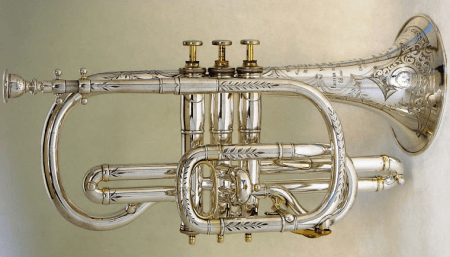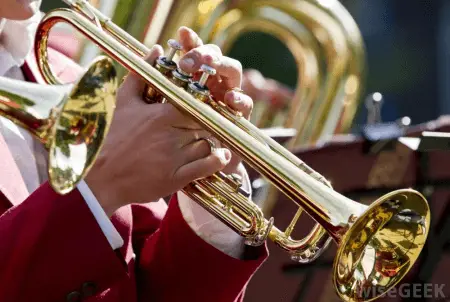If placed side by side, most people would think cornets are just trumpets. Although related, cornets and trumpets are separate musical instruments with several defining qualities. This article highlights these differences.
Summary Table
| Cornet | Trumpet |
| More rounded in appearance | Oblong/elongated and slender in shape |
| Has valves as pitch control | Either valves or slide for pitch control |
| Conical bores | Cylindrical bores |
| Lower pitched, darker timbre | Higher pitched, direct, and piercing sound |
Definitions

A cornet is a brass instrument mainly used for jazz, concert bands, brass bands and special orchestras that require a more melodic sound. It has a conical bore (interior chamber) and a compact shape with numerous bends in its tubes along where the valves are placed. The conical bore may not always be visible from the outside, but this adds to the cornet’s ability to produce its mellow tone quality.
The diameter of the tube is narrow at the mouthpiece and widens towards the end (or the bell), which also gives the instrument its warm sound quality. It also has a shorter, narrower shank and a deeper cup compared to the trumpet, which gives the cornet the ability to produce a lower, darker timbre and pitch.
The cornet produces sound by the player vibrating (i.e. buzzing) the lips in the mouthpiece of the instrument. This action creates a vibrating stream of air in the tubing. The player makes use of facial muscles and various lip shaping techniques (called embouchure) on the cornet’s mouthpiece. Proper embouchure allows the cornet player to perform and use the full range of the instrument without experiencing muscle damage.

A trumpet is a brass instrument usually played in jazz, classical music, and popular music. Trumpets are also played in art music styles such as in concert bands and orchestras. Trumpets hold the distinction of having the highest register among brass instruments. A trumpet is made of brass tubing bent twice to form a rounded oblong shape.
A trumpeter employs proper embouchure to hit desired pitch among a range of overtones. Embouchure also helps prevent facial muscle damage. Sound is produced when the player blows air into the mouthpiece through closed lips, thereby creating a “buzzing” sound into the circular rim of the mouthpiece. Air is channeled to the shank or the back bore into the trumpet’s lead pipe using the cup located behind the rim. The size of these components directly affects the quality of sound and ease of use. In most cases, a bigger cup produces a darker timbre and sound.
Cornet vs Trumpet
So, what’s the difference between a cornet and a trumpet? The trumpet’s major bends are located away from the valves, compared with the cornet bends, which is near the valves. Unlike the cornet, which only has pistons for valves, some trumpets have rotary valves, which are slightly different in appearance, but serve the same purpose of lengthening the tube to produce lower pitches. The main factor that makes the sound of the trumpet different than that of the cornet is its cylindrical bore. Compared to a cornet, the diameter of the tube of the trumpet from the mouthpiece going to the valves, bends and up to the bell’s groove is approximately constant, giving it a brighter, much higher pitch and tone quality. The pitch that the trumpet creates is considered more penetrating than the cornet, making it much more heard in unison. It has a longer and wider shank, giving it a lighter, more fan-fare tone.
Video
Here’s a conductor and cornet soloist providing a brief discussion about cornets and trumpets.






